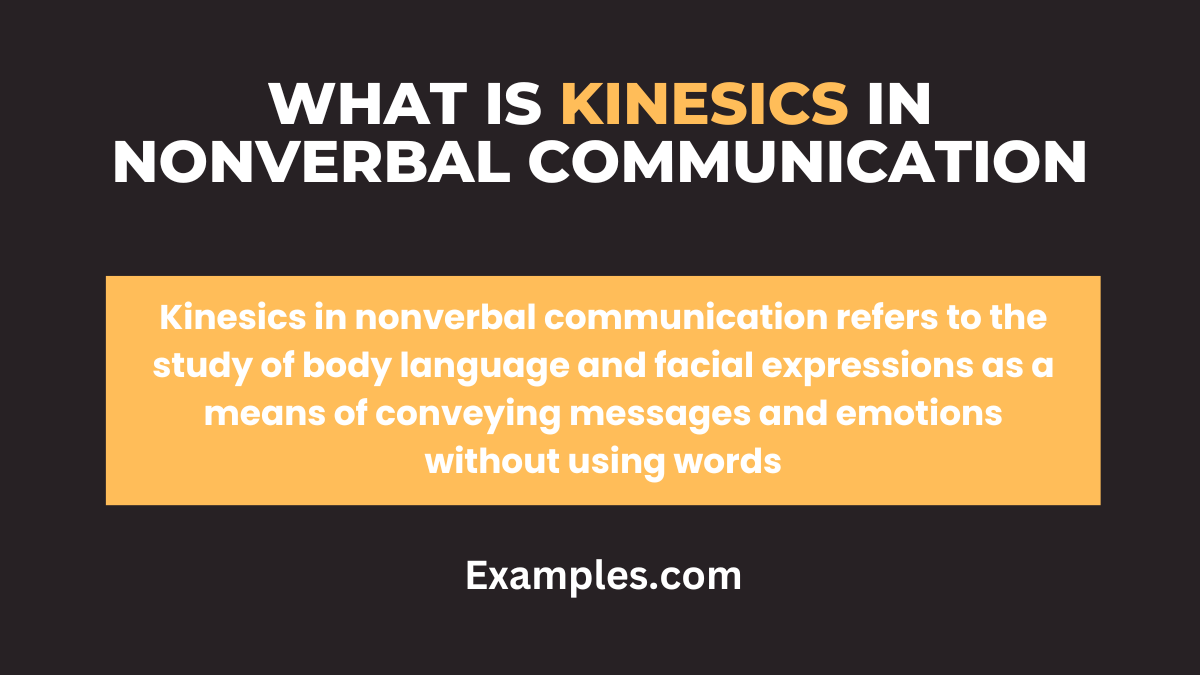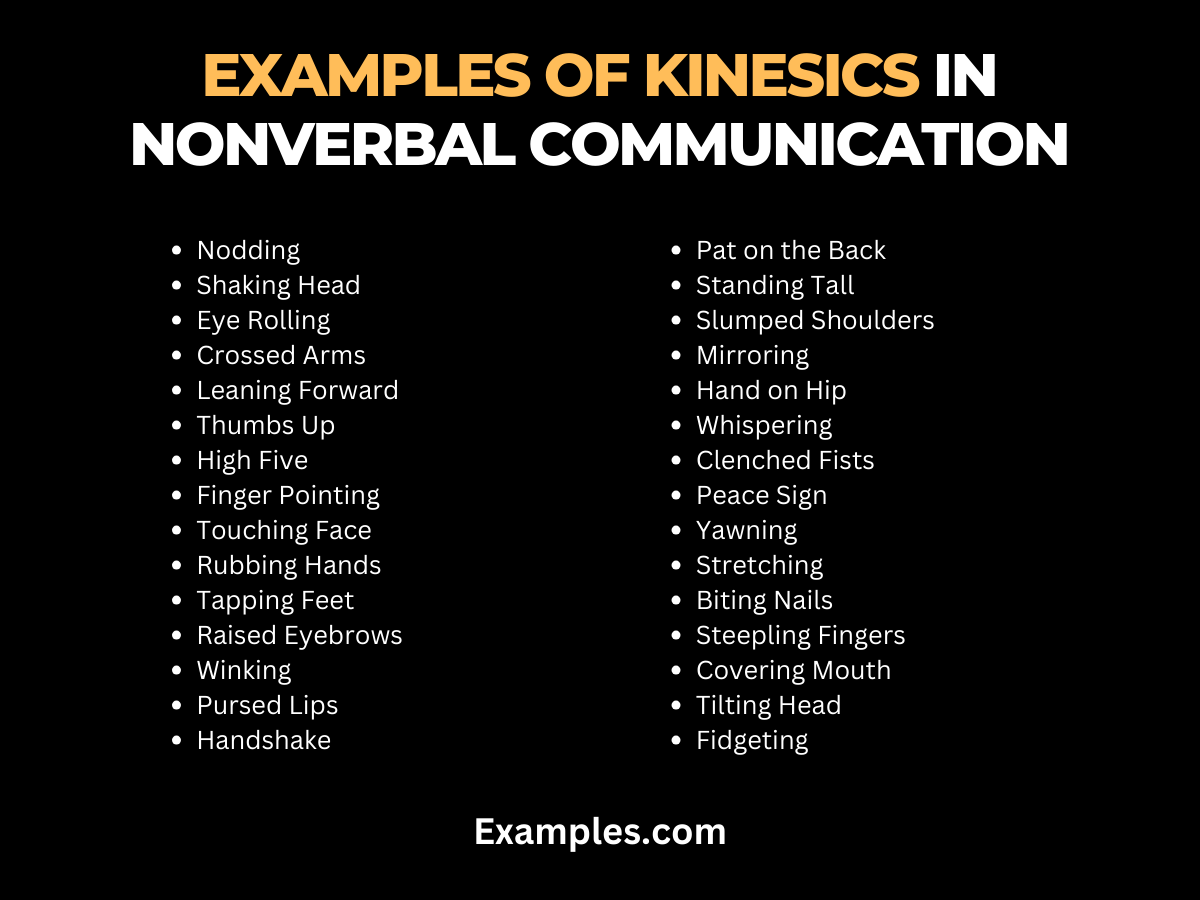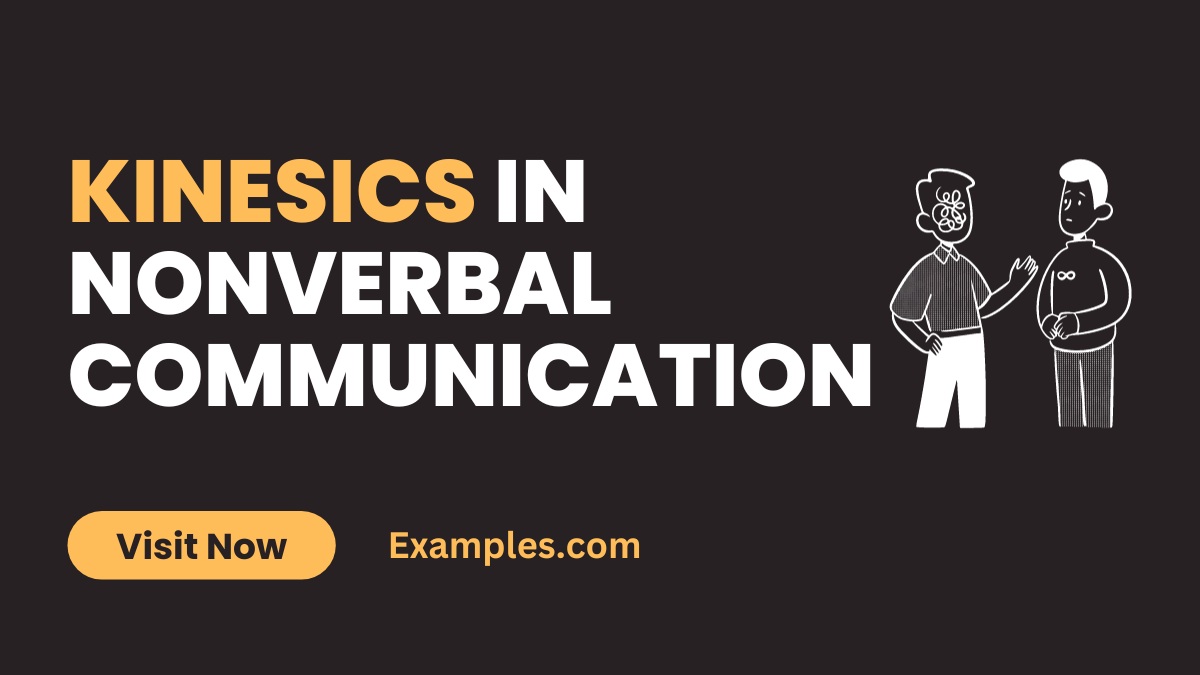29+ Kinesics in Nonverbal Communication Examples
Kinesics in Nonverbal Communication plays a pivotal role in conveying messages without words. This comprehensive guide delves deep into the art and science of body movements, gestures, and facial expressions that constitute a major part of interpersonal communication. Understanding kinesics enhances our ability to interpret the unspoken elements of dialogue, offering a richer, more nuanced understanding of social interactions.
What is Kinesics in Nonverbal Communication?

Kinesics, a term coined by anthropologist Ray Birdwhistell, refers to the interpretation of body motion used in communication. It encompasses various aspects such as facial expressions, gestures, posture, and body movements. Understanding kinesics is crucial for deciphering the unspoken elements in conversations and can significantly enhance interpersonal communication skills. This section explores the different types of kinesics and their roles in conveying nonverbal messages.
What is the Best Example of Kinesics in Nonverbal Communication?

Kinesics, a crucial aspect of nonverbal communication, encompasses the various ways body movements and gestures convey meaning without the use of words. These nonverbal cues play a significant role in how we interpret and interact with others. Understanding kinesics can enhance personal and professional interactions, providing deeper insights into unspoken messages.
1. Facial Expressions in Nonverbal Communication
Facial expressions are potent indicators of emotions and intentions. A smile, frown, or raised eyebrows can convey happiness, disapproval, or surprise, respectively. These expressions are universally recognized and form the basis of empathetic communication. For instance, a genuine smile, often called a Duchenne smile, not only shows happiness but also creates a feeling of trust and warmth in the observer.
2. Body Language in Nonverbal Communication
Body language includes posture, stance, and the way we move our limbs. An open posture, where arms are relaxed or open, typically suggests openness and friendliness. In contrast, crossed arms might indicate defensiveness or resistance. Similarly, leaning towards someone often signifies interest, while leaning away might suggest discomfort or a desire to withdraw.
3. Gestures in Nonverbal Communication
Gestures are specific movements, like nodding for agreement, shaking the head for disagreement, or waving for greeting or farewell. These actions can vary significantly across cultures but are an integral part of conveying messages without words. For instance, a thumbs-up in many Western cultures means approval or ‘good’, but it may have different interpretations in other parts of the world.
4. Eye Contact in Nonverbal Communication
Maintaining eye contact is a powerful aspect of kinesics. It can demonstrate attentiveness, confidence, and sincerity. However, the amount of eye contact considered appropriate can vary culturally. In some cultures, direct eye contact is seen as confrontational, while in others, it is a sign of respect and engagement.
5. Fidgeting in Body Language of Nonverbal Communication
Fidgeting, such as tapping feet or playing with objects, often indicates nervousness, boredom, or impatience. These signals can provide insight into a person’s comfort level and emotional state during an interaction.
6. Nodding in Interactions for Nonverbal Communication
Nodding is a common gesture in many cultures, typically indicating agreement or acknowledgment. Rapid nodding might suggest eagerness or impatience, whereas slower nodding usually signifies thoughtful agreement.
7. Space (Proxemics) in Nonverbal Communication
Proxemics, the study of personal space, is an essential element of kinesics. The distance maintained during communication can convey various messages, from intimacy and comfort to authority and detachment.
30 Examples of Kinesics in Nonverbal Communication

Kinesics, a key part of nonverbal communication, plays a vital role in conveying messages without words. Here are 30 distinct examples, each demonstrating how body movements and gestures can communicate a wide range of emotions and intentions
- Nodding: Indicates agreement or understanding.
- Shaking Head: Shows disagreement or disbelief.
- Eye Rolling: Suggests annoyance or disbelief.
- Crossed Arms: Can imply defensiveness or resistance.
- Leaning Forward: Shows interest or engagement.
- Thumbs Up: A universal sign of approval or agreement.
- High Five: Indicates celebration or agreement.
- Finger Pointing: Can be aggressive or accusatory.
- Touching Face: Often signifies thinking or uncertainty.
- Rubbing Hands: Shows anticipation or excitement.

- Tapping Feet: Indicates impatience or nervousness.
- Raised Eyebrows: Expresses surprise or inquiry.
- Winking: May convey playfulness or shared knowledge.
- Pursed Lips: Suggests disapproval or skepticism.
- Handshake: A gesture of greeting or agreement.
- Pat on the Back: Indicates support or congratulations.
- Standing Tall: Reflects confidence or readiness.
- Slumped Shoulders: Shows sadness or lack of confidence.
- Mirroring: Copying someone else’s body language, showing empathy or agreement.
- Hand on Hip: Can suggest readiness or aggression.
- Whispering: Implies secrecy or intimacy.
- Clenched Fists: Indicates anger or determination.

- Peace Sign: A symbol of friendship or victory.
- Yawning: Signifies boredom or tiredness.
- Stretching: Indicates restlessness or a need for a break.
- Biting Nails: Reflects anxiety or nervousness.
- Steepling Fingers: Shows confidence or contemplation.
- Covering Mouth: Can suggest shock or an attempt to hide a reaction.
- Tilting Head: Shows curiosity or confusion.
- Fidgeting: Indicates discomfort or restlessness.
Role of Kinesics in Nonverbal Communication
Kinesics plays several key roles in nonverbal communication:
- Expression of Unspoken Emotions: Body language often reveals true emotions that might not be verbally expressed. For example, a clenched fist can indicate anger or frustration.
- Regulating Conversations: Nodding or using hand gestures can signal when it’s someone else’s turn to speak, thereby regulating the flow of conversation.
- Substituting Verbal Messages: In some situations, kinesics can completely substitute for verbal communication, such as a thumbs-up signifying approval.
- Contradicting Verbal Messages: Sometimes, body language can contradict what is being said verbally. For instance, saying “I’m fine” with a tense body posture might indicate the opposite.
- Influencing Perceptions: How you present yourself through kinesics influences how others perceive you. Confident body language can lead to a positive impression
Importance of Kinesics in Nonverbal Communication
Understanding the importance of kinesics can greatly improve interpersonal interactions:
- Enhances Verbal Communication: Kinesics complements and enhances verbal communication. Gestures or facial expressions can add emphasis or clarity to the spoken word.
- Conveys Emotional State: Body language often conveys emotions more effectively than words. For example, crossed arms might indicate defensiveness or discomfort.
- Facilitates Understanding: In cross-cultural communication, where language barriers exist, kinesics can play a vital role in conveying messages.
- Feedback Mechanism: Observing others’ kinesics provides feedback. For instance, if your audience is nodding, they are likely following and agreeing with you.
- Building Rapport: Effective use of body language helps in building rapport and trust. Mirroring body language can create a sense of empathy and understanding.
How to Use Kinesics in Nonverbal Communication
Kinesics, a crucial aspect of nonverbal communication, involves understanding and using body language effectively. Here’s how you can use kinesics to enhance your communication skills:
- Awareness of Body Movements: Start by being aware of your own body movements. This includes gestures, facial expressions, and posture. For instance, open gestures like spreading your arms can signify openness and acceptance.
- Facial Expressions: Utilize facial expressions to convey emotions. A smile can indicate friendliness, while a frown may express disapproval. Facial Expressions in Nonverbal Communication are powerful tools for conveying emotions without words.
- Posture and Stance: Your posture can communicate confidence or uncertainty. Standing straight with shoulders back conveys confidence, while slouching might indicate a lack of it.
- Gestures: Use gestures to emphasize points. Gestures like nodding can affirm understanding, while pointing can be used to direct attention.
- Eye Contact: Maintaining appropriate eye contact is crucial. It signifies attention and respect. However, too much or too little can be uncomfortable or misconstrued.
- Contextual Relevance: Ensure your body language is appropriate for the situation. What works in a casual setting may not be suitable in a formal environment.
For enhancing your article on “Kinesics in Nonverbal Communication,” consider integrating external links from authoritative and relevant sources. A link from the National Communication Association (https://www.natcom.org) provides insights into various aspects of communication studies, including nonverbal cues. Another valuable resource is the American Psychological Association (https://www.apa.org), offering research and articles on body language and psychology. Additionally, Harvard University’s Program on Negotiation (https://www.pon.harvard.edu) shares practical insights on nonverbal communication in negotiation and conflict resolution. These links are from esteemed organizations and educational institutes, aligning with your guidelines of adding value and credibility to your article.



